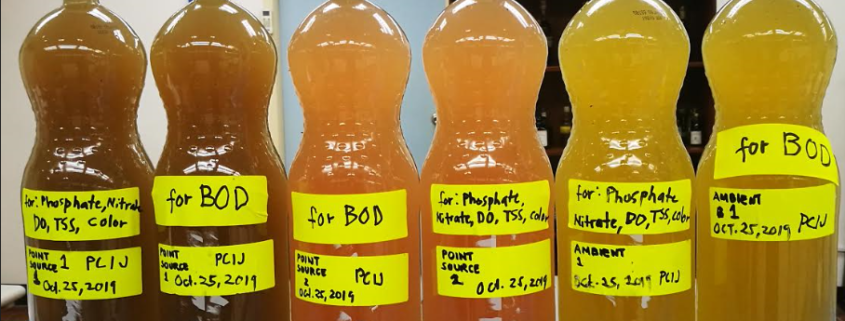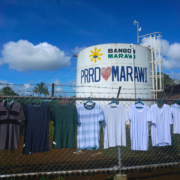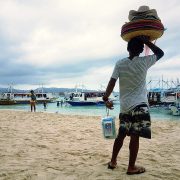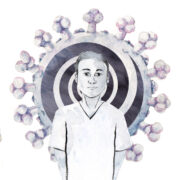Marilao’s poultry processing plants fail lab tests
Reporting fellows of the Philippine Center for Investigative Journalism (PCIJ) collected water samples from the waste pipes of plants along the Marilao River. Laboratory tests show they failed to meet DENR standards.
BY ANNIE RUTH SABANGAN, ROBERT JA BASILIO JR., BERNARD TESTA AND RIC PUOD
Part 4 of 4
Part 1: The Bulacan town where chickens are slaughtered and the river is dead
Part 2: ‘The wastewater looked like mud’: EMB goes after Vitarich Corp.
Part 3: Marilao River polluters get away with small fines
What you need to know about Part 4:
- The PCIJ collected water samples from the poultry processing plants in Marilao and laboratory tests showed they failed to meet the standards of the Department of Environment and Natural Resources.
- To help police pollution, a lawyer-environmentalist suggests that non-government organizations help the government evaluate the SMRs of business establishments.
It was low tide when the PCIJ team made a second trip to Sapang Alat or Salty Creek on Oct. 2, 2019, a week after the first. Renting another outrigger was out of the question as it couldn’t sail through the shallow waters. The team rented a rickety canoe instead, and asked the help of a boatman to paddle towards Vitarich Corporation’s outfall pipes.
PCIJ set out to take more samples of wastewater that the company released to the creek, a tributary of the Marilao River, to bring them to a laboratory accredited by the Department of Environment and Natural Resources (DENR).
In the succeeding weeks the team also trekked to Brgy. Loma de Gato, home to the biggest number of poultry dressing plants, to do the same.
Results of the laboratory tests confirmed what residents already knew. The plants had been releasing wastewater that did not meet DENR’s standards.
Water sample: PCIJ follows instructions from experts
The samples were brought to the laboratory of the Sugar Regulatory Administration (SRA) in Quezon City.
The PCIJ team made sure to follow instructions from SRA chemists on how to take samples, how much should be taken, where to put the specimens, and by what time the samples must reach the laboratory for testing.
To ensure that the samples were representative of the conditions of the area, PCIJ also followed the guidelines set by the EMB in its 2008 Water Quality Monitoring Manual, which said samples should not be collected when (1) it’s raining; (2) it’s within 24 hours after a heavy downpour; and (3) the water level is high.
Wastewater from poultry processing contains high biochemical oxygen demand or BOD and four other oxygen-depleting and fish-killing pollutants: total suspended solids (TSS), ammonia, nitrate and phosphate.
Based on DENR standards, the BOD of wastewater produced by slaughtering and meat packing businesses like chicken dressing plants should not exceed 50 milligrams per liter (mg/l).
A high BOD indicates that the wastewater is untreated or undertreated, and thus polluted. A low BOD suggests that the contaminants had been removed from the wastewater and would have less environmental impact when released to a water body.
TSS are solid materials such as silt, sewage, and decaying animal matter. In poultry processing plants, these may include the buildup of feathers, fat and lard, offal, viscera, blood, and fecal matter in the wastewater.
The release of liquid waste with too much TSS will block the sunlight from reaching the vegetation in a water body, causing the plants to die and stop producing dissolved oxygen needed by fish to survive.
Ammonia in the form of ammoniacal nitrogen (NH3-N), a colorless chemical gas compound highly soluble in water, can be found in the liquid manure of chickens and other livestock. This type of ammonia can “cross from water to fish” and is said to be the “the most toxic form to aquatic life.”
Chemical compounds nitrate and phosphate, commonly used as fertilizers, can be present in fecal matter expelled by poultry before the birds undergo scalding.
Wastewater containing too much nitrate and phosphate can hasten the process called eutrophication, or the increase of nutrients that induces the overgrowth of algae. This can cause the water body to turn green and reduce its oxygen content to levels that can also lead to fish kills.
Other than these five parameters, the Environmental Management Bureau (EMB) of the Department of Environment and Natural Resources (DENR) measures three others – oil and grease, acidity or pH, and temperature – to test the quality of wastewater discharges of these establishments.
The chicken dressing industry in Marilao River –– a Class C freshwater resource meant for fish propagation, agricultural use, fishing, and boating –– is required to follow all eight parameters, based on DENR Administrative Order (DAO) 2016-08 or the Water Quality Guidelines and General Effluent Standards of 2016.
The regulations are strict on paper but they are not always implemented, based on PCIJ’s experiment.
Vitarich Corp. fails tests
The laboratory results were out five days after PCIJ submitted the water samples from Sapang Alat.
The lab results of Vitarich Corp. showed mixed results. The level of pollution in the water sample collected from the mouth of the dressing plant’s former outfall was lower than the effluent limits set by the EMB in terms of BOD, TSS, nitrate, and color.
The water samples were collected nine months since the EMB cemented off a canal where the dressing plant’s effluents used to flow.
However, samples from the effluent outfall from the rendering plant that Vitarich operates jointly with PSP Aqua yielded BOD and TSS levels that were 346 percent and 15 percent higher than the EMB-set effluent limits, respectively.
These results were based on water samples that the PCIJ team collected on Oct. 2, 2019.


The PCIJ learned from the Legal Section of the EMB’s Clearance and Permitting Division that as of Oct. 28, 2019, the violation notice and cease-and-desist order against the rendering plant had been temporarily lifted so that the facility could release its wastewater for sampling purposes.
PCIJ also obtained samples from the part of the creek between Marilao’s Municipal Health Office and the Vitarich dressing plant to determine the ambient water quality of Sapang Alat. They were tested for five parameters, namely BOD, DO, TSS, nitrate, and color.
The area was within the mouth of the creek that emptied into the Marilao River. Upstream, along Brgy. Patubig, the creek meandered through a host of other industrial and commercial establishments, which could also be possible sources of pollution.
Water quality failed in all parameters, indicating that because of very high pollution levels, it could no longer receive wastewater and still be able to breathe and cleanse itself.

Even if industrial establishments like Vitarich discharged wastewater into Sapang Alat within the effluent limits, the creek would no longer be able to take it in because it has already stagnated, said EMB Region 3’s Glenn Aguilar, who monitors the Marilao River.
Sapang Alat’s BOD was over 3,600 times higher than its 7 mg/l capacity, causing the creek’s DO concentration to fall to the “hypoxic” or oxygen-deprived level of 1.13 mg/l.
Based on an undated report on hypoxia by the US Environmental Protection Agency (EPA), conducted in the Gulf of Mexico and Long Island Sound, bottom fishes start to leave water bodies when oxygen levels reach about 3 mg/l. Fish and crustaceans that cannot leave the area may die when it goes below 2 mg/l, and then begin to die in large numbers when it goes below 1 mg/l.
In the Philippines, there is yet no comprehensive study about hypoxia, or the depletion or reduction of oxygen in water bodies, particularly on how aquatic species react under low-oxygen conditions.

Follow the stench: PCIJ checks other plants in Loma de Gato
EMB’s Aguilar said other chicken dressing plants in Marilao were inaccessible to inspectors. Sometimes, the pathway is dangerous.
To verify this claim, the PCIJ team trekked to Loma de Gato, Marilao’s most populated barangay and home to the biggest number of poultry dressing plants accredited by the Department of Agriculture’s National Meat Inspection Service (NMIS).
While data from the NMIS showed that there were four dressing facilities in Loma de Gato, mostly tucked away in an area called Pook Looban 1, the information was hard to validate via on-site investigation even though the stench was all over the place.
Most of what appeared to be industrial or commercial premises in Looban 1 didn’t have outdoor signages. Some establishments were enclosed by walls higher than roofs and trees, while others were smack in the middle of sprawling lots buffered from roadways.
The PCIJ also failed to pinpoint dressing plants within Looban 1 via Google’s web and mobile apps.
Asked by PCIJ during an interview in October 2019 if not having business signages was legal, Marilao BPLO chief Martin Armando C. Cruz said, “Hindi naman din (It isn’t).”
There should be an ordinance from the municipal council prohibiting the lack of signages, he said.
Cruz also claimed that some establishments had opted not to install outdoor signages to avoid unwanted solicitations for money.
Much harder to locate were the dressing plants’ wastewater outfalls. Several times, the PCIJ team waded through the boggy and mosquito-infested edges of Marilao River’s tributaries to look for point-source pipes and drains.
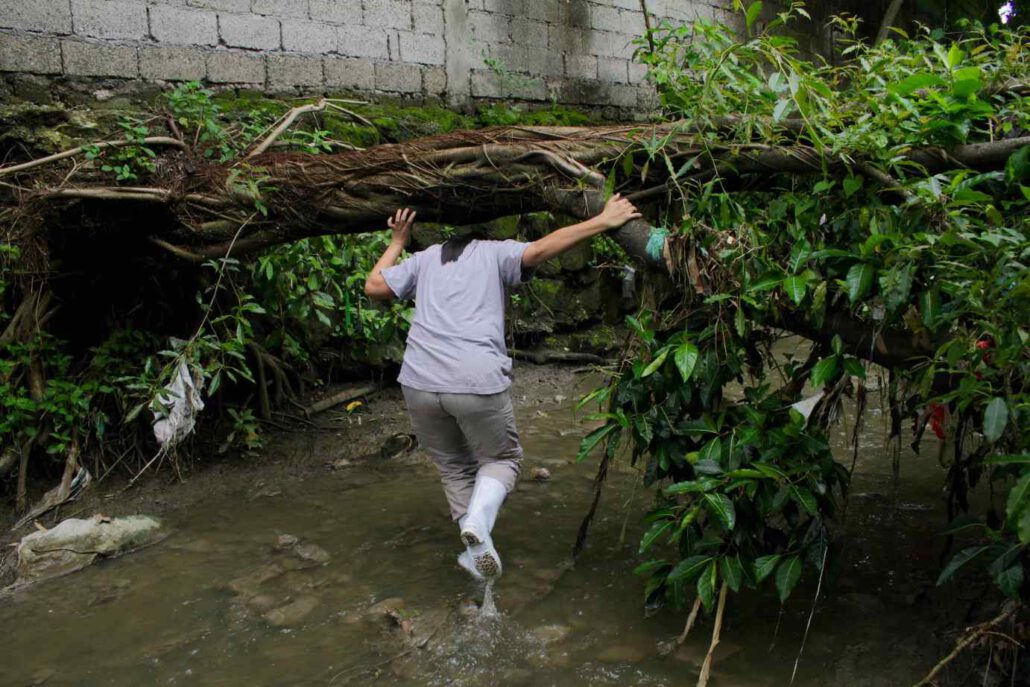
In one field visit, the group walked by the roadside and saw a stream where the water was cascading, indicating that direct pollution sources could be farther upstream.
But it was impossible to walk on the narrow banks of the stream sandwiched between an expansive walled property and a row of houses.
Taking instructions from a resident, the PCIJ team tried to find another path toward the water body through an inner road that led to a cemetery.
At the back of the graveyard, the team saw the stretch of the stream beside a nameless, walled establishment that appeared to be the extension of a property earlier seen by the team from the roadside.
From the side of the establishment, the PCIJ team saw at least three outfalls protruding from the streambank that appeared to be connected to the walled property, which residents claimed was a poultry processing plant.
Staggering on mossy rocks that stuck out of the streambed, the group inspected the muddy water body that was filled with strands of what looked like chicken feathers.
The team also saw water ̶ brown, orange, to reddish in color ̶ gushing out of the three outfalls and into the stream.
Too much phosphate
Early morning on Oct. 25, 2019, the team returned to the area to get wastewater samples from two of the outfalls. The PCIJ had these tested again by the SRA lab for BOD, TSS, nitrate, phosphate, and color.

Lab results showed that effluents from both outfalls failed in three of the five parameters’ effluent limits, namely BOD, TSS, and phosphate.
Results indicated that the wastewater did not undergo treatment and had a very high degree of pollution, as BOD concentrations from the first and second outfalls were 5,584 percent and 4,850 percent higher than the government-set 50 mg/l-effluent limit, respectively.
Also, phosphate concentrations in the effluents were markedly high. The phosphate content of the wastewater in the first outfall was over 8,000 times higher than the 1 mg/l limit set by the EMB, while in the second, the phosphate level was nearly 7,000 times greater than the cap.

Phosphate is used as a poultry product enhancer. The injection of water with phosphate salts into chicken meat is among the steps in poultry processing. This is done to help the protein in the meat bind more water and retain moisture and flavor.
Researchers had found that the phosphorous-protein content of enhanced meat and poultry products was 28 percent higher than in the same types of product that didn’t use phosphate additives.
This was according to a 2009 study titled “Phosphorous and Potassium Content of Enhanced Meat and Poultry Products: Implications for Patients Who Receive Dialysis,” by nephrologists Richard Sherman and Ojas Mehta of the New Jersey-based Robert Wood Johnson Medical School.
In water bodies, too much phosphate is known to hasten eutrophication or the buildup of nutrients, causing microscopic plant-like organisms called phytoplankton to reproduce rapidly.
This results in the overproduction of that slimy stuff called algae that can make water bodies appear green, brown, red or blue; and form foam, scum or oily films on their surfaces.
More algae mean higher consumption of dissolved oxygen in water, depriving aquatic life such as fish of the life-sustaining gas, leading to the latter’s death.
The PCIJ team also had the ambient water quality of another Marilao River tributary in Looban 1 tested by the SRA laboratory.
The group took samples after observing that the outflow of water into the creek, which was near high-walled establishments, was like a flood of frothy latte continuously pouring from a giant coffee machine.
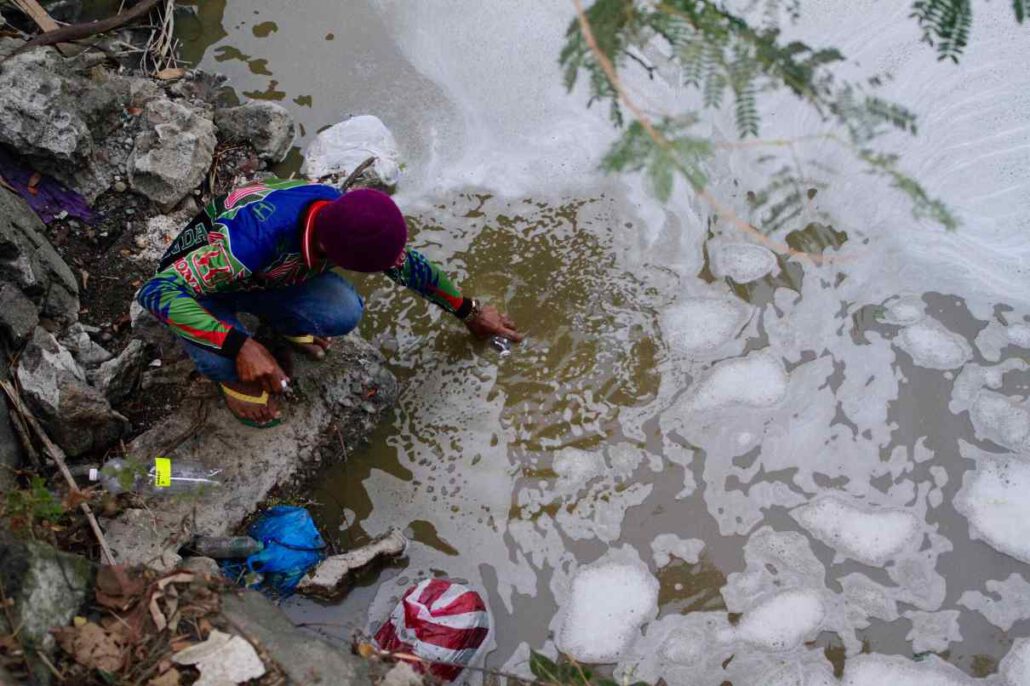
Like Sapang Alat, the river tributary in Brgy. Sta. Rosa 1 earlier tested by the SRA, this creek in Brgy. Loma de Gato also failed the water quality standards set by the EMB on BOD, DO, TSS, nitrate, phosphate, and color.
But the pollution in this creek was much worse. Its demand for oxygen ̶ 1,279 mg/l ̶ was over 18,000 times higher than the EMB standard of 7 mg/l. Inversely, its oxygen concentration was extremely low at 1.16 mg/l.
Also, the phosphate level in the creek was way too high at 48 mg/l, or 9,500 times more than the limit of 0.5 mg/l for Class C water bodies or those, according to the EMB, that should be fit for aquatic resource propagation, fishing, boating, agriculture, irrigation, and livestock watering.
Effective, lasting solutions needed
Because of years of abuses by private companies amid weak environmental governance and the failure of regulation, Marilao River is dead and blackened by pollution.
Narrowed and shallowed by volumes of harmful contaminants, the barren and pernicious river can no longer repair itself. During high tide and heavy rains, it often threw up the wastes it could no longer absorb, submerging communities in toxic, persistent floods.
More lasting and effective solutions are not in sight. Could it be time for a third-party entity to intervene and help fill the gap?
Lawyer and environmentalist Galahad Pe Benito thinks so, and says the non-profit sector should take the lead.
Benito, who used to practice in California and is now campaigning for the rehabilitation of the Manila Bay and the tributaries surrounding it, said environmental self-policing worked in other countries because people’s organizations were ready to “pounce on” pollutive business establishments.
The SMR system is ineffective because compliance is weak and there are no nongovernment organizations (NGO) to countercheck the SMRs, he said.
“Walang mga NGOs dito to do the counterchecking and everything…Dito mahina ang compliance natin, so medyo may problema onhow to implement that,” said Benito, who specializes in hazardous and toxic waste regulation, marine pollution, and pollution control.
The responsibility of monitoring pollution point sources and evaluating SMRs can be assigned by the government to NGOs or to “respectable and independent auditors,” Benito said.
NGOs’ access to SMRs should not be a problem because under the law, these reports are considered public documents.
The procedural manual of DAO No. 2007-23 states that, “Upon completion of EMB’s evaluation, the SMRs are considered as public documents.”
“As such, access [to] these documents by written request of the general public shall be allowed in accordance with applicable rules and regulations.”
The manual further noted that, “The SMR was designed in such a way that there is no need for confidential business information to be included in the submission.” — PCIJ, February 2021
This series was produced with the support of Greenpeace Southeast Asia-Philippines.— PCIJ

